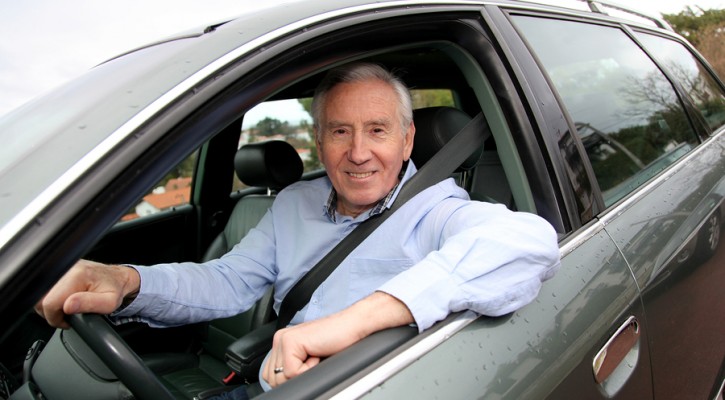Tag Archive: elderly drivers

Older Drivers Can Be Aided By Technology
July 17, 2015
When it comes to older drivers, stereotypes aren’t necessarily true. Years ago, safety experts predicted a traffic nightmare as baby boomers reached old age but that hasn’t turned out to be the case. In fact, traffic data from the Insurance Institute of Highway Safety shows that traffic deaths among drivers 70 and older have been on a steady decline since the high point in 1997.
There are fewer drivers over the age of 70 and they tend to drive fewer miles. Safety experts feel that many older drivers “self regulate”; that is they tend to restrict driving to less busy times of the day and they avoid driving at night. Another reason for the decline in deaths of older drivers is that older drivers tend to be healthier and have better medical care than drivers in the past.
It’s impossible to tell at what age a driver is too old to drive. It depends on the individual driver and everyone ages at a different rate. A new study published recently tracked 1000 people born in 1972-73. Using a range of biomarkers, they found that the biological age of the one-thousand 38 year olds ranged from 30 to 60 years apart. Some were aging rapidly while others aged very slowly.
Still, it’s undeniable that most people will reach an age when they’ll no longer be able to drive and many families will face the difficult decision of when to take away the keys.
However, for those drivers reaching their 70’s and still driving safely, technology has the answer to help them to continue to drive safely and, hopefully, reduce the fears that any family members may have. If they can afford it, a new car with the following features can help to keep them and any other driver, regardless of their age, safer on the road. While these packages may cost a bit more, their price may be offset by a reduction in insurance costs.
- Collision Avoidance – Collision avoidance technology uses a combination of either radar, lasers, and cameras to keep an eye on vehicles and pedestrians ahead. Those systems work together to warn a drivers if they’re approaching too closely to another vehicle or object. If the driver doesn’t heed the warnings, the system will apply the brakes and stop the car.
- Lane Departure Warning and Prevention – This system warns a driver if the vehicle is drifting out of the lane and uses the dynamic braking system to steer the car back into the lane if the driver doesn’t take action.
- Adaptive Headlights – This system turns the headlights in the direction of the wheels to illuminate the road more clearly on curves.
- Blind Spot Detection – This system uses sensors to detect other vehicles in a driver’s blind spot to warn a driver who’s about to move into another lane or who may be drifting over the line. These systems can either warn the driver or work together with the lane departure system to prevent a driver from moving over.
To find a list of vehicle manufacturers who offer these technologies, visit: Insurance Institute for Highway Safety – Crash avoidance features by make and model

Taking The Keys Away From Elderly Drivers
February 18, 2009
More and more adult children each year are facing the heart rending decision of taking the car keys away from elderly parents whose driving behavior has become a danger to themselves and others. This isn’t an easy decision to make because it represents the elderly driver’s sense of independence and dignity. For anyone facing this choice, there are some valuable tools to help you with your decision.
There is no set age at which a driver is no longer able to drive; some drivers maintain their vision, reflexes and physical abilities well into their 80s and 90s while others, due to diseases such as heart disease or diabetes may face the decision of giving up their license in their 50s. The data shows that elderly people, due to their fragility and health issues stand a greater chance of becoming a fatality in a traffic collision but the good news, from an Insurance Institute for Highway (IIHS) study released in December, shows that the death rate for elderly drivers declined steadily between 1997 and 2006 compared to drivers in other age groups. There is no definitive data showing why the death rate for elderly drivers has declined but it is felt that elderly drivers are “self limiting” their driving by no longer driving at night, making shorter trips and avoiding interstates. There is also a feeling that more drivers are surrendering their license on their own when they can no longer pass the vision test or they come to the conclusion on their own that they no longer possess the ability to drive safely.
For those that refuse to surrender their license, the American Association of Retired Persons (AARP) provides the following warning signs:
- Feeling uncomfortable and nervous or fearful while driving
- Dents and scrapes on the car or on fences, mailboxes, garage doors, curbs etc.
- Difficulty staying in the lane of travel
- Getting lost
- Trouble paying attention to signals, road signs and pavement markings
- Slower response to unexpected situations
- Medical conditions or medications that may be affecting the ability to handle the car safely
- Frequent “close calls” (i.e. almost crashing)
- Trouble judging gaps in traffics at intersections and on highway entrance/exit ramps
- Other drivers honking at you and instances when you are angry at other drivers
- Friends or relatives not wanting to drive with you
- Difficulty seeing the sides of the road when looking straight ahead
- Easily distracted or having a hard time concentrating while driving
- Having a hard time turning around to check over your shoulder while backing up or changing lanes
- Frequent traffic tickets or “warnings” by traffic or law enforcement officers in the last year or two
The child, relative or caregiver concerned about the safety of an elderly driver should follow these steps:
- Start a dialogue with the elderly driver expressing your concerns
- Suggest that the driver limit their driving to avoid night driving or long trips.
- Review any medications or medical issues that could diminish the driver’s reflexes and vision or stress causing issues that could affect their driving behavior.
- Travel along with the elderly driver and either videotape or keep notes of missed signs, near misses, confusion etc. Unless you need to intervene to prevent a collision, don’t comment during the drive; it will only make the driver more nervous. Review your findings after the trip.
- Consult with the driver’s doctors to see if any medical issues may limit the driver’s abilities to drive safely.
- Hold an intervention with family members and concerned friends to try to convince the driver to voluntarily stop driving.
The IIHS has information about elderly drivers and a list of state laws concerning elderly drivers at http://www.iihs.org/iihs/topics/t/older-drivers/topicoverview
Drivers in metropolitan areas who are physically unable to drive may be eligible for door to door paratransit transportation. To locate paratransit operators in your area, contact your local county government.
If all else fails and you feel the situation is too dangerous, take the keys and remove the car.
